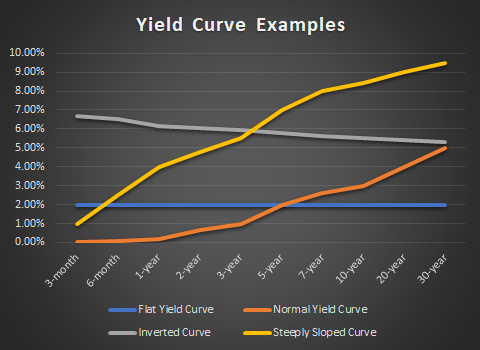Reflected as a line graph, the yield curve plots interest rates at a certain point in time. Used most commonly to graph are the 3-month, 2-year, 5-year, 10-year and 30-year U.S. Treasury debt. The shape of the curve can be used as an indicator for debt in the market and can also be used to indicate how inflation will affect the economy.
Types of Yield Curve
The yield curve can take five different shapes: normal, inverted, flat, steep, and humped.
- Normal Yield Curve: A normal shaped yield curve indicates that long-term investments will garner a higher yield than short-term investments.
-
A normal yield curve occurs when the market is expecting greater compensation due to greater risk. For instance, long-term bonds are subject to more risk and the investor cannot touch the money during that time, so they are compensated more for their investment. One of the main reasons a yield curve will take this shape is because there is an expected decline in inflation.
-
 Inverted Yield Curve: An inverted yield curve indicates that long-term investments will garner a higher yield than short-term investments.
Inverted Yield Curve: An inverted yield curve indicates that long-term investments will garner a higher yield than short-term investments.
-
An inverted yield curve, the rarest form of curve, occurs when short term treasuries have higher yields than long term treasuries, this is often a predictor of inflation. The cause of this occurrence can often be attributed to a weak economy. When the economy is weak, long-term rates will often be lowered to accommodate and offset the weakening of the economy, which causes short-term opportunities to present a higher return.
-
- Flat Yield Curve: Furthermore, a flat yield curve means that there is a negligible difference between short and long-term interest rates.
- This type of yield curve is often seen during economic transitions, when the curve is transitions from flat to normal, or vice versa. The most common cause of a flattening yield curve it the falling of long-term interest rates due to investors being nervous about the economic outlook and over corrected for the perceived upcoming turmoil.
- Steep Yield Curve: is an extreme variation of the normal yield curve, where the yield curve has an exaggerated upward slope.
- A steep yield curve occurs when long-term interest rates are increasing at an amount severely quicker than short-term rates. This increase happens when the U.S. Treasury Department submits a plot of debt that indicates the economy is about to go through a period of rabid economic expansion.
- Humped Yield Curve: is another very rare form of curve where medium-term interest rates are higher than both short and long-term interest rates.
- As stated before, a humped yield curve is rather uncommon, but on those occasions that it does occur it is usually due to uncertainty in investors regarding new economic policies or a change in conditions. A humped yield curve can also be a signal of market volatility due to the market being in flux and not having a true direction.
The U.S. Debt and Global Demand
In 2018, we are witnessing a flattening of the US yield curve, with interest on short-term debt rising, and long-term declining. According to the Treasury, the two-year yield rate sits at 2.95% while the ten-year rate sits at 3.17% (numbers accurate as of October 2018). A suspected reason of the rising rates of short-term treasuries is the growing deficit of US debt. As it stands today the government is issuing more short-term treasuries, which in turn is raising the cost of short-term funds.
Another reason long-term yields could be decreasing is the increase of global demand. According to US Treasury data, foreign investors increased their holdings in the US market by 27 billion in the month of May 2018. This trend could be due to the global perception that US treasuries are a safer option, and smarter investment during times of global economic turbulence, which we are certainly weathering. Due to this uptick in holdings, the feds are having trouble keeping up with markets thus leaving their balance sheets behind the market, which could be exaggerating the flattening of the U.S. yield curve. To combat this, the Fed may need to speed up its balance sheet reduction program.
Factors of Inflation
 Inflation is another factor that has a direct relationship with yield and interest rates. When talking about the yield curve and bonds we must always take inflation into account, because the Federal Open Market Committee (FOMC) is always concerned with inflation. For example, if the FOMC were to hold short-term interest rates low for too long, it actually puts the economy at risk for rampant inflation because it puts too much money into the economy when it is going after fewer goods.
Inflation is another factor that has a direct relationship with yield and interest rates. When talking about the yield curve and bonds we must always take inflation into account, because the Federal Open Market Committee (FOMC) is always concerned with inflation. For example, if the FOMC were to hold short-term interest rates low for too long, it actually puts the economy at risk for rampant inflation because it puts too much money into the economy when it is going after fewer goods.
Often times, this economic turmoil and rise in short-term rates is due to inflation. Inflation can also be the cause attributed to why short-term rates move so rapidly. When the Fed raises short term rates, long-term rates should increase as well to reflect the initial raise, however, that is not the case. The increase on the long-term rates is hamstrung because expectations on higher short-term rates should predict lower inflation on the back-end (long term bonds). Essentially the regulations get tripped up over themselves and cause a flattening in the curve.
While it is believed that this instance of the flattening curve will not lead to another recession it is still bad news for banks due to the higher interest on short term rates. In October 2018, we saw a STEEP drop in the Dow Jones and Nasdaq, which likely can be attributed to inflation and classified as a market correction. We have seen the stock market creep back up since then, but things are still uneasy.
One thing is for certain, the yield curve in relation to inflation is something that is to be monitored in the coming months and should be taken seriously as the flattening could have a direct impact on our nation’s economy.
Visit the RJO Futures Learning Center – RJO Futures is your one-stop brokerage for futures trading education. You can use our resources to build your trading knowledge, and learn to trade futures and options on futures for the financial and commodities markets. See below for a listing of articles, guides, and webinars to help you along the path to being a more successful trader.

